Watermelon is a popular summer fruit that’s delicious and nutritious. It’s a great source of vitamins A and C and potassium. While watermelons can be enjoyed fresh, they can also be used in recipes such as salads, smoothies, and even sorbet. Several factors are necessary to know if you want to grow your watermelon plant. Everything you need to know about growing and taking care of watermelon plants is included in this article.
History of Watermelon Plant:
The watermelon is thought to have originated in Africa, where it has been cultivated for thousands of years. The first recorded mention of the watermelon was in Egypt, where it was depicted on ancient carvings. The Bible also mentions watermelons brought to the New World by European explorers.
Today, watermelons are grown in many parts of the world, including the United States, China, and Japan. Watermelon is usually considered a summer fruit in the United States, often harvested from June to August.
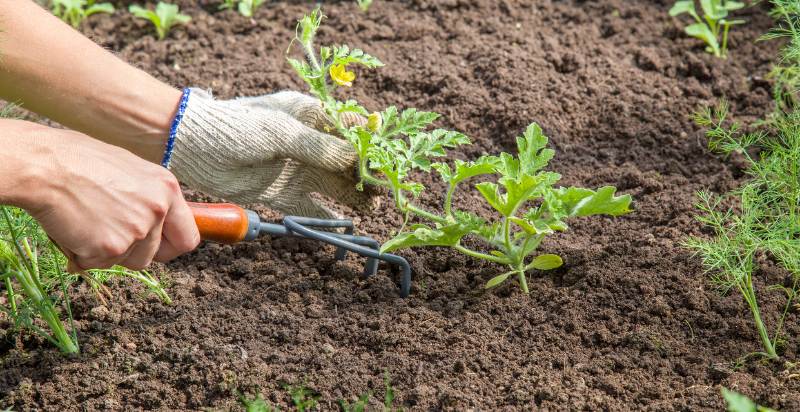
Types of Watermelons:
Many types of watermelons come in various shapes, sizes, and colors. The most common type of watermelon is round, weighing up to 50 pounds (23 kilograms). There are also elliptical or oval-shaped watermelons and small, personal-sized watermelons.
Watermelons can also be either seedless or have seeds. Seedless watermelons are becoming more popular, as they are easier to eat and don’t require spitting out seeds. However, seeded watermelons are often cheaper and easier to find in stores.
When it comes to color, watermelons can be either red, pink, yellow, or white on the inside. The exterior of the watermelon is usually green with stripes or spots.
Watermelon Nutrition’s:
Watermelon is also a good source of vitamins A and C and potassium. It’s also low in calories and fat-free. One cup (152 grams) of watermelon contains:
- 46 calories
- 11 grams of sugar
- 1 gram of protein
- 0.4 grams of fiber
- 8% of the RDI for vitamin A
- 21% of the RDI for vitamin C
- 10% of the RDI for potassium
Watermelon Health Benefits:
As a good source of vitamins, minerals, and antioxidants, watermelon provides a wide range of possible health advantages. Here are some potential health benefits associated with watermelon:
- May Improve Heart Health: Citrulline, an amino acid plentiful in watermelon, is associated with better heart health. Citrulline may help reduce inflammation and keep your arteries healthy.
- Boost Hydration: Watermelon is about 92% water, making it a great food to eat if you want to increase your fluid intake.
- Aid In Weight Loss: Watermelon is low in calories and water content, making it a great food for people trying to lose weight.
- Improve Digestion: Watermelon contains fiber and water, which are important for healthy digestion. Water keeps things moving smoothly, while fiber gives stools bulk and aids food digestion.
How To Grow Watermelon Plant?
If you’re interested in growing your watermelons, there are a few things you’ll need to know. Here’s what you need to know about growing watermelon plant:
Watermelons are a type of cucurbit, which includes squash, pumpkin, and gourds. All cucurbits need full sun to produce good fruit yields, so choose a planting site accordingly. They also require well-drained, nutrient-rich soil with a pH between 6.0 and 6.8. If you need more clarification about your soil’s quality, have it tested by your local cooperative extension office.
Before planting, work 2 to 3 inches of organic matter into the top 6 to 8 inches of soil to improve drainage and increase nutrients and moisture retention. Watermelons are heavy feeders and will need regular fertilizer applications throughout the growing season.
Start seeds indoors in peat pots three to four weeks before the last frost date in your area. Sow seeds ½ inch deep and keep the soil moist but not soggy. Once seedlings have two to three true leaves, thin them so that only the strongest plant remains in each pot.
Transplant seedlings into the garden after all danger of frost has passed and the soil has warmed to at least 70 degrees Fahrenheit. Space plants are 5 to 6 feet apart in rows 8 to 10 feet apart. Bury plants up to their first set of leaves, encouraging root growth and making the plant more drought-tolerant.
Watermelons need 1 to 2 inches of water per week, so be sure to provide them with a consistent supply throughout the growing season. Mulching around plants also helps to conserve moisture and prevent weeds.
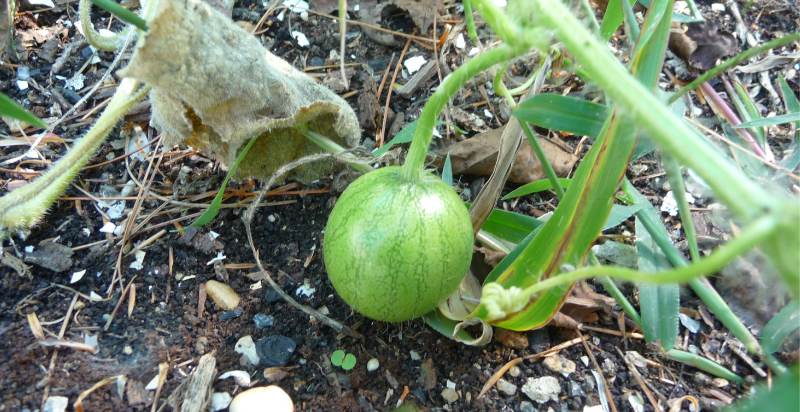
Prevention From Pests And Diseases:
Watermelons are susceptible to several pests and diseases, so monitoring your plants closely and taking action as needed is important. Some common problems include cucumber beetles, powdery mildew, and anthracnose.
Cucumber beetles can be a serious problem for watermelon plant, as they can transmit a disease called cucurbit yellow vine decline (CVD). Start your seedlings indoors and cover young plants with a floating row cover to prevent infestation. Remove any weeds or other plant debris from around the garden area, as this can provide a place for cucumber beetles to overwinter.
A fungus called powdery mildew can make leaves turn yellow and die. It can also affect the plant’s fruits, causing them to rot. To prevent powdery mildew, water plants at the base rather than from overhead and remove any affected leaves.
Anthracnose is another fungal disease that can cause fruit to rot. It can also affect the leaves and stems of the plant. To prevent anthracnose, water plants at the base rather than from overhead and remove any affected leaves or fruit.
To keep your crop healthy, keep a close eye out for pest or disease signs on your plants and take necessary action. With a little caution, you can enjoy a plentiful harvest of delectable watermelons.
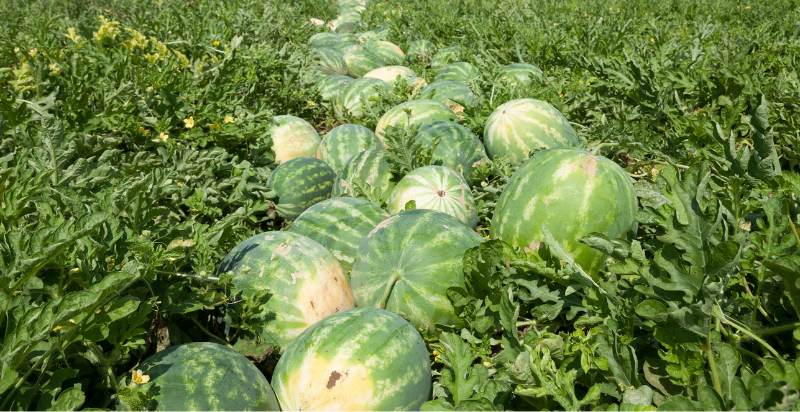
Harvesting:
Fruit will be ready to harvest 75 to 80 days after planting. To check for ripeness, gently thump the watermelon—it should sound dull, not hollow. Looking at a watermelon can also help you determine when it’s ripe for a curly tendril on the stem near the fruit; if it’s dry and brown, the melon is ripe. Use a sharp knife to cut watermelons from the vine being careful not to harm the plant.
After harvest, remove all fallen leaves and debris from around the plants to help prevent fungal diseases. Watermelons are susceptible to several pests and diseases, so monitor your plants closely and take action as needed. With proper care, you can enjoy a bountiful harvest of delicious watermelons.
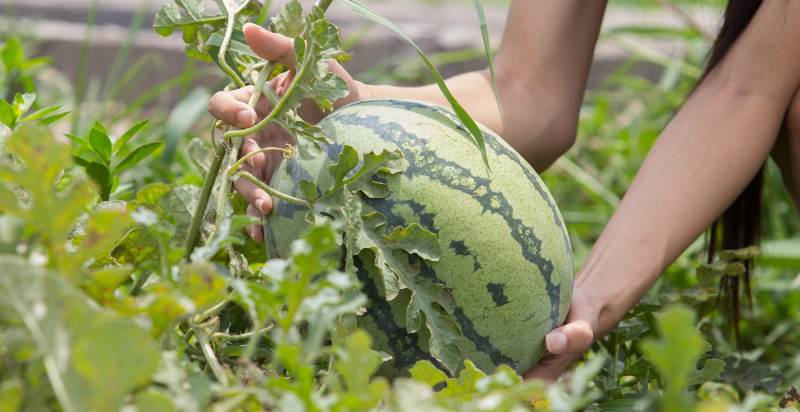
How Do Store-Grown Watermelons?
The watermelon should be stored in a cool, dry place like a cellar. It is best to keep them in a single layer so they stay away from each other. Put something soft, like a cloth, between the watermelon layers if you need to stack them.
You can also wrap each watermelon in a newspaper before storing them. Check on the watermelons every few days and remove any that are starting to rot. Eating a rotten watermelon can make you very sick.
Some additional tips regarding growing the watermelon :
- Choose the right variety: Choose a variety of watermelons suitable for your climate from the many available options.
- Start from seed: Watermelons are best started from seed, as transplanted seedlings can be susceptible to shock.
- Give them space: Watermelon plant need plenty of room to grow; planting them in an area with at least 6 feet (1.8 meters) of space in all directions will provide them the space they need to flourish.
- Provide support: As watermelons can get quite large, it’s a good idea to provide support for the vines by tying them to a trellis or other structure.
- Water regularly: Watermelons require consistent watering, especially during the fruiting stage. Keep the soil moist but not drenched.
- Harvest at the right time: Watermelons are ripe when the skin turns dull, and the fruit sounds hollow when tapped. Cut the watermelon from the vine, careful not to damage the stem.
- Store in a cool, dry place: Up to two weeks of watermelon storage is possible at room temperature. Please keep them in a cold, dry place, like a basement or root cellar, to keep them for a longer amount of time.
Although watermelon plant are fairly easy to grow, some important things must be kept in mind to ensure a good harvest. You can enjoy watermelons straight from your garden if you take a little time and care.

Risks
Some risks are associated with eating watermelon, as it contains sugar and can cause digestive issues in some people. Here are a few potential risks to be aware of:
- Cause bloating: Watermelon is high in water content and contains fiber, both of which can lead to bloating.
- May cause diarrhea: Watermelon is also high in water content, which can loosen stool and lead to diarrhea.
- May worsen GERD symptoms: Some people with gastroesophageal reflux disease (GERD) may find that watermelon worsens their symptoms. This is likely due to the fruit’s high acidity.
How to Eat Watermelon?
Watermelons are a delicious and refreshing summer fruit. There are many different ways to eat watermelon. However, one of the most common approaches is to cut it into slices or cubes and eat it that way.
If you want to get a little more creative, add watermelon to salads, smoothies, or even grilled dishes. Just be sure to enjoy this sweet treat in moderation, as it does contain natural sugars.
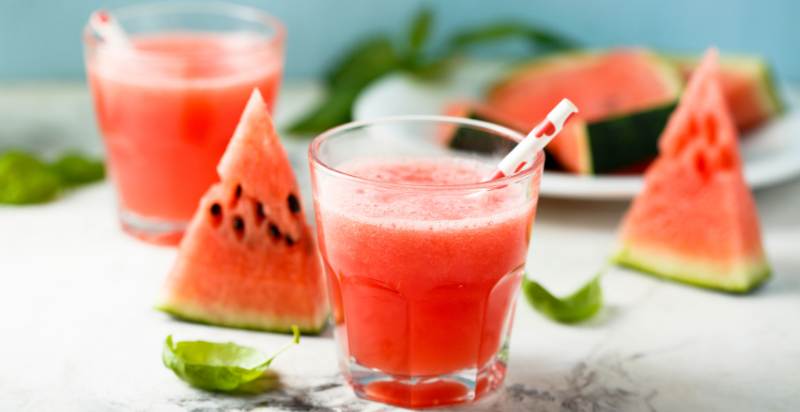
Conclusion
Watermelon is a very refreshing and healthy fruit that can be enjoyed in many different ways. While there are some potential risks to be aware of, these are generally mild and only affect a small percentage of people. With proper care, you can enjoy a bountiful harvest of delicious watermelons.
- Everything You Wanted to Know About Red Tamarillos - June 2, 2025
- A Guide to Tulips: Everything You Need to Know & More… - June 2, 2025
- Guanabana: Description, Flavor, Benefits, And Uses - May 27, 2025

11 thoughts on “Watermelon Plant: How to Grow and Care for Watermelon Vine”
Comments are closed.